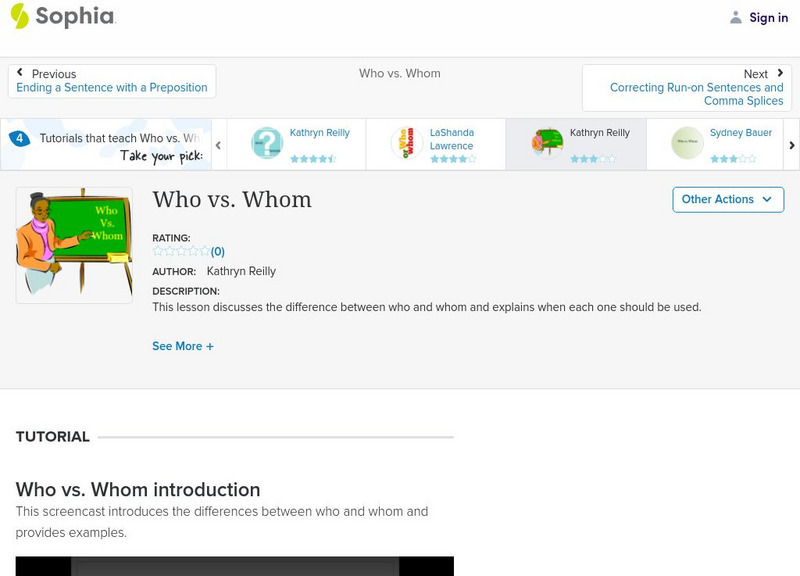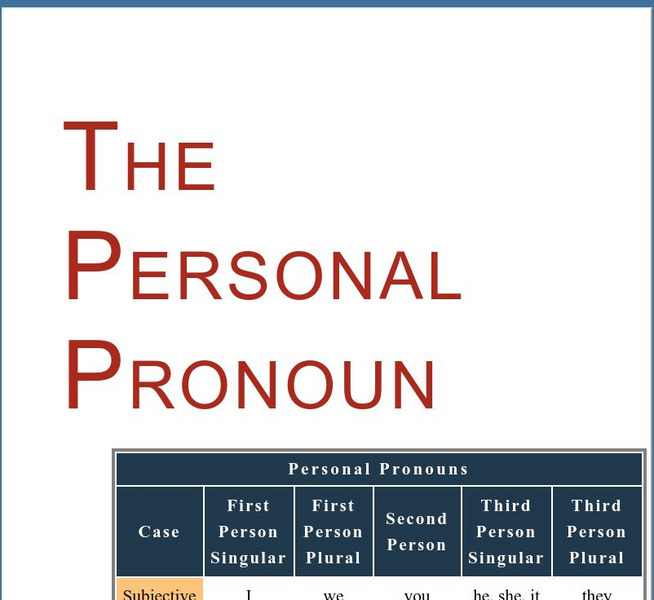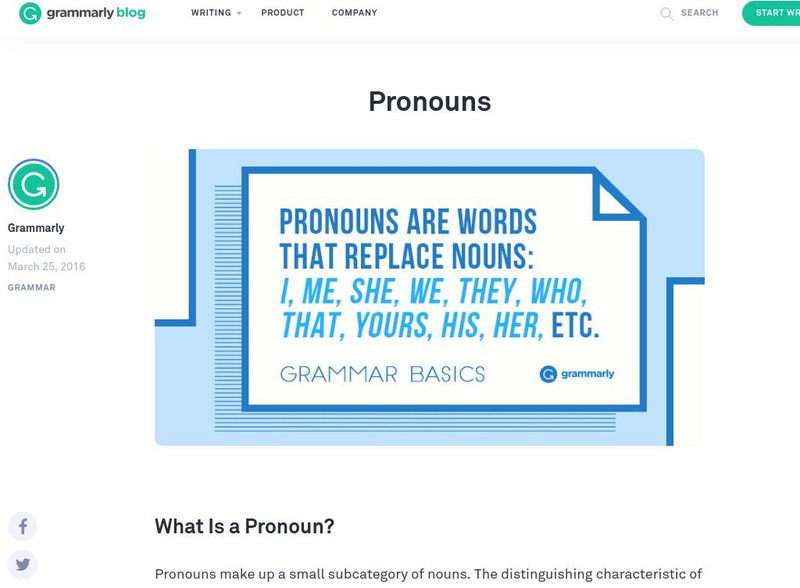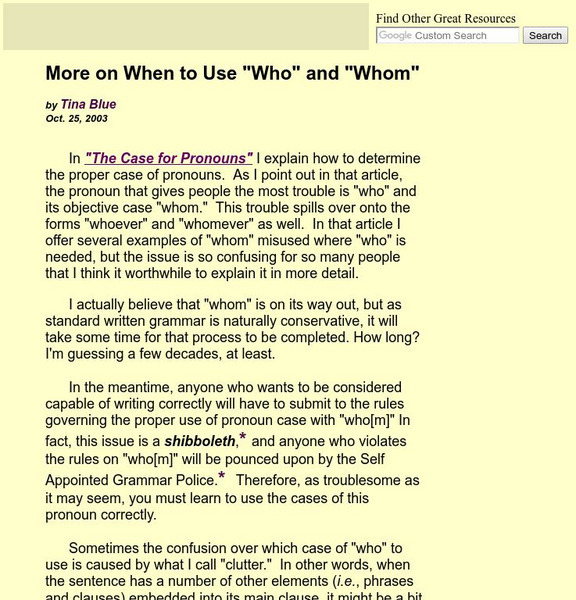Sophia Learning
Sophia: Adjective Clauses and Relative Pronouns
This slideshow lesson focuses on adjective clauses and relative pronouns; it discusses the purpose of adjective clauses and the three conditions required to be an adjective clause. It provides the two adjective clause formulas with...
Sophia Learning
Sophia: Who vs. Whom
This video lesson focuses on the use of who and whom in sentences. It provides background information including part of speech and the purpose of each, explains each individually with examples, and offers a memory trick to apply with...
Texas Education Agency
Texas Gateway: Reciprocal Pronouns (English Ii Writing)
Understand the function and use of reciprocal pronouns such as each other and one another.
Towson University
Towson University: Online Writing Support: Usage Pronoun Case
This entry focuses on using the correct pronoun case to fit the pronoun's function in the sentence. It provides rules and examples of subjective, objective, and possessive case usage, the correct usage for who and whom, and other case...
The Write Place
Literacy Education Online: Pronoun Antecedent Agreement
This page details the agreement between the use of pronouns and antecedents.
Robin L. Simmons
Grammar Bytes: The Demonstrative Pronoun
Printable information is provided that demonstrates how to identify a demonstrative pronoun in the context of a sentence.
Robin L. Simmons
Grammar Bytes: The Personal Pronoun
Printable information is provided that demonstrates how to identify a personal pronoun in the context of a sentence.
Other
Lesson Snips: Pronoun Relative: Using Relative Pronouns [Pdf]
Ready-to-print notes and examples of relative pronouns along with a practice worksheet and answer key.
Other
University of Western Ontario: Pronouns [Pdf]
This pronoun tutorial requires that your browser support Adobe Acrobat.
Grammarly
Grammarly Blog: Pronouns
This page focuses on pronouns including definitions, personal pronouns, antecedents, relative pronouns, who vs. whom, demonstrative, indefinite, reflexive and intensive, possessive, and interrogative pronouns. Examples are provided for...
Capital Community College Foundation
Guide to Grammar and Writing: Consistency of Tense and Pronoun
Brief instruction on maintaining pronoun and verb tense consistency. Links to additional help and quiz are included.
Towson University
Towson University: Online Writing Support: Self Teaching Unit: Pronoun Case
This lesson focuses on pronoun case including subjective, objective, and possessive case. It provides examples of each and also discusses personal pronouns, reflexive / intensive pronouns, and the use of Who and Whom. It offers links to...
Get It Write
Get It Write: "I" and "Me"
To understand the correct usage of "I" and "me," you need to learn about the subjective and objective case of pronouns. This tutorial does a great job explaining that and giving good examples for you to follow. A brief quiz checks your...
TED Talks
Ted: Ted Ed: When to Use "Me", "Myself" and "I"
Me, myself, and I. You may be tempted to use these words interchangeably because they all refer to the same thing. But in fact, each one has a specific role in a sentence: 'I' is a subject pronoun, 'me' is an object pronoun, and 'myself'...
Grammar Tips
Grammar Tips: More on When to Use "Who" and Whom"
A great tutorial on the use of the pronouns, "who" and "whom," which are often confused. Many examples are given as are fool-proof ways to check whether the correct one is being used.
Other
Tidewater Community College: Writing Center: Pronoun Agreement
This site has information on guidelines for proper pronoun usage. Topics covered include agreement in person, number, and gender.
PBS
Pbs Learning Media: How to Use Intensive Pronouns
Intensive pronouns add needed emphasis to a sentence. While they function similarly to reflexive pronouns, they differ in that the pronoun can be removed without altering the meaning of the sentence. [0:57]
PBS
Pbs Learning Media: Reflexive Pronouns and Subjects
Reflexive pronouns reflect the subject of the sentence. A reflexive pronoun is a pronoun that is preceded or followed by the noun, adjective, adverb, or pronoun to which it refers within the same clause. [0:35]
PBS
Pbs Learning Media: Proper Case for Pronouns
Pronoun case is determined by how we use the pronoun in a sentence. There are three ways: subjective, when the pronoun does something; objective, when something is done to our pronoun; and possessive, when our pronoun possesses...
PBS
Pbs Learning Media: How to Avoid Inappropriate Shifts
Watch out for inappropriate shifts in pronoun number and person! A shift is when there is a disparity between the perspectives, from first person, second person, and third person. It is important to maintain perspectives when referring...
Khan Academy
Khan Academy: Emphatic Pronouns
Are these pronouns being used for emphasis, or does the sentence need them in order to make sense?







![Lesson Snips: Pronoun Relative: Using Relative Pronouns [Pdf] Activity Lesson Snips: Pronoun Relative: Using Relative Pronouns [Pdf] Activity](https://static.lp.lexp.cloud/images/attachment_defaults/resource/large/FPO-knovation.png)









